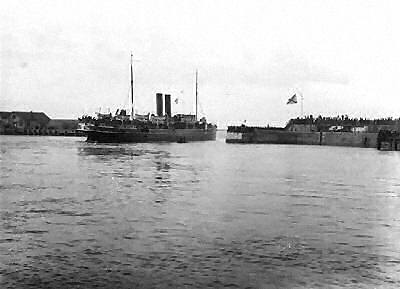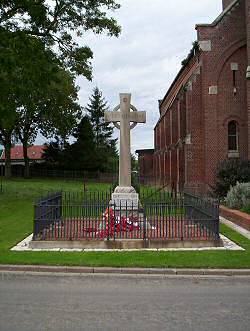|
|
The Channel Islands and the Great War
|
|
The Jersey
Contingent
A Brief History
|
|
Preparations for War
On 4th March 1915, after a tiring two day journey, the
men of the Jersey Company arrived at the training camp
of the 7th Royal Irish Rifles, which was located near
the small town of Buttevant in the heart of beautiful
County Cork.
The next six months were spent here; learning to be soldiers
in the modern British Army - and generally enjoying the
genial hospitality of their Irish hosts. Whilst they were
in Ireland they were joined by a further 89 volunteers
from Jersey. As a result, the Jersey Company was strengthened,
and the Contingent was able to detach men to fill other
roles within the 7th Royal Irish Rifles, including 26
to form the Battalion's Machine Gun Section and a number
who became Signallers. There was a further detachment
in August when those men considered unsuitable for active
service left to join a reserve battalion in Dublin.
The remaining members departed the Emerald Isle at the
start of September and moved to Aldershot in order to
complete their training and organise for war. The 7th
Royal Irish Rifles was part of the 48th Infantry Brigade,
which in turn was part of the newly formed 16th (Irish)
Division, and these two formations were working up here
in southern England in preparation for crossing to the
Continent. By December everything was ready: on the 19th
they embarked for France.
|

The Contingent departs Jersey on 2nd March on SS
Ibex
(Société Jersiaise)
|
|
At The Front
The Contingent spent its first eight months in a section
of the Western Front north of Arras, in the vicinity of
the small French town of Loos. Reputedly a "quiet"
sector, the trenches here were used at the time for introducing
newly arrived units to the rigours of trench warfare,
and train them to survive in this most unforgiving of
environments. Regardless of reputation however, frontline
duty at Loos quickly proved to be as dangerous as elsewhere.
Shelling, sniping, trench raids and poison gas soon began
to claim victims from the Contingent, as well as sickness
and debilitation brought on by dreadful conditions that
winter.
The first casualty occurred in January when one of the
men was wounded by a sniper. The first fatality came in
March, when 2nd Lieutenant Laurence Hibbs died of fever.
And a few days later the first death in action occurred
when Captain Johnson, the Company's second in command,
was killed by a shell near the village of Vermelles.
It was a pattern that continued throughout the spring
and summer. A total of 11 men died whilst the Contingent
was at Loos, and many others were evacuated wounded or
ill.
|
|
The Battle of the Somme
The Battle of the Somme started on the 1st of July 1916.
Along a 20 mile stretch of the front, a combined British
and French offensive was launched, with the broad aim
of breaking through the enemy lines and advancing into
the open country behind. Tenacious German defence had
quickly put this plan on hold, and in the months that
followed more of a slogging match took place as the allies
advanced slowly from position to position. By the start
of September, in the east of the Battlefield, the fighting
had reached the village of Guillemont; but despite several
assaults, this key location remained in German hands.
The 16th (Irish) Division had been brought south from
Loos to join the battle at the end of August, and a few
days later the first elements were committed to an assault
on Guillemont. On 3rd September the village was taken
with great élan by the soldiers of the 47th Brigade,
and the Germans pushed back. Two failed, in response the
Germans had heavily shelled Guillemont throughout the
day and the Jersey Company, which was manning the perimeter
defences, suffered considerable casualties as a result.
Two days later, on 5th September, 7th Royal Irish Rifles
were sent into Guillemont with orders to garrison the
ruins, and defend them against possible German counter-attack.
On the next day, the British attempted to capture Ginchy,
another village lying around half a mile to the north-east.
Although this attack, with Ginchy still firmly in German
hands, 16th (Irish) Division was ordered to prepare for
another assault on the village on 9th September. 7th Royal
Irish Rifles were chosen as one of the battalions to take
part in the first wave of the attack: their duty being
to advance across no-man's land and capture the village
itself. At 4:50 in the afternoon the offensive began.
The Jersey Company, its strength by now down to less than
fifty men, successfully made it into the ruins of Ginchy
and played their part in the fight to overcome the stubborn
German defenders. By the end of that day the job was done,
and the battalion was marched off the battlefield and
on to a rest camp located behind the lines.
Five days of fighting in the Battle of the Somme had cost
the Contingent - and the Island of Jersey - dearly. Twenty
members were killed at Guillemont / Ginchy, and over 100
more wounded, many of them seriously.
|

Guillemont Memorial Today
|
| |
|
 Page 1
Page 1 |
Page 3  |
|
|